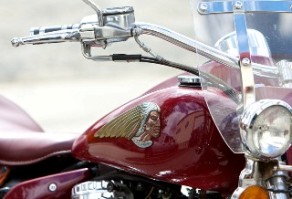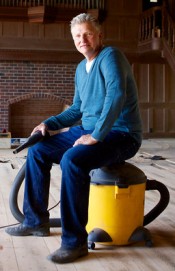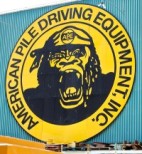Hammering man: John White
Inventor of mammoth machines, reinvents himself in the Foster EMBA Program
You could call John White (EMBA 2012) many things. Inventor. Entrepreneur. Scholar. Philanthropist. Restorer of rare antiquities. Teller of rousing tales.
How about Renaissance man?
Let’s not get carried away. We’re talking about a uniquely American icon-in-the-rough, more rock-and-roll than lute and lyre. A tall-walking bear of a man who ran off to join the carnival when he was 14, enlisted in the Marines at 17, and made his bones in the heaviest of industries.
White is the founder of American Piledriving Equipment, the world’s foremost manufacturer of vibratory hammers that drive the foundations for the massive structures of modern civilization—skyscrapers, statues, stadiums, oil rigs, wind turbines, bridges. Especially bridges.
He’s been enthralled by these abiding symbols of human ingenuity ever since he was a kid in West Seattle, when an old neighbor would regale him with tales from his days flying bombing runs in World War II. “He said he could never take out the old Roman bridges in Italy and France,” White recalls. “They were just too solidly built.”
Ground up
White’s role in the advancement of transport construction began humbly enough. After his stint in the military and a spell at community college, he was hired as a mechanic by Pacific American Commercial Company, fixing pile drivers from around the world that were surplussed after the construction of the Alaska Pipeline.
Eventually, he became a walking encyclopedia on the subject. “I didn’t realize it at the time,” he says, “but I was, perhaps, the only person on the planet who had been exposed to all of these hammers.”
North Carolina-based International Construction Equipment sought his expertise to coax its shoddy pile drivers to work on the West Seattle Bridge project in the early 1980s, then hired him to manage its west coast operations. But White eventually wearied of trekking from southern California to northern Alaska to install and service hammers that were always breaking down. “When you’re up in Prudhoe Bay, you don’t care how much you saved if the machine doesn’t work,” he says. “So I set out to make the world’s best pile driver.”
Build a better hammer…
After White left ICE, he founded APE in his White Center garage. His first creation was a small hammer that used vibration rather than concussion and heavy tungsten rather than steel to drive piles in tight spaces, a design perfectly suited for Boeing’s seismic retrofit of its facilities in the late 1980s.
White received his first patent in 1992. And the next day he was introduced to Pat Hughes (BA 1957), owner of several rock and gravel companies in the Northwest. They became partners in APE—White president and Hughes CEO.
“We were a great team,” White says. “Pat was an incredible mentor; working with him was like being enrolled in the Pat Hughes School of Business—an extraordinary learning experience in the real world. He said to keep on inventing. And 40 patents later, we were the world’s largest manufacturer of vibratory pile drivers. We revolutionized the industry.”
White designed progressively bigger and more efficient diesel impact hammers, best on land, and vibratory hammers, more effective and environmentally gentle in water. Locally, APE had a hand in constructing Safeco and Century Link Fields, the new waterfront Great Wheel, and is working on the new 520 Bridge. It helped build bridges in Iraq and Afghanistan, and repaired the Haitian port after the 2010 earthquake. APE now dominates the vibratory hammer market in North American and parts of Asia, and is a growing presence in Europe and South America.
For China, a nation setting new standards for mega construction, White designed the largest pile driver in history. Today his OctaKong, a 500,000-pound vibro hammer, is driving 72-foot diameter steel piles deep into the South China Sea to support the 31-mile Hong Kong-Zhuhai-Macau Bridge.
Reinventing the inventor
Despite being president of APE, White was always more comfortable in his role of inventor. In 2010 he decided it was time to learn the management and financial side of business. So he enrolled in the Foster School’s Executive MBA Program.
Three decades removed from his last classroom experience, White found he was a pretty good student. He soaked up faculty wisdom, polished his interpersonal skills, and grew into the heart-and-soul of a tight-knit class (after studying Ernest Shackleton in a leadership course, White bought his colleagues each a replica bottle of the legendary Antarctic explorer’s recently recovered stash of whiskey).
He also learned that he was ready—and able—to navigate his own future. “It didn’t matter if I was CEO of an antique store,” White says. “After 20 years as second in command, I wanted to run my own ship.”
He sold his stake in APE toward the close of the program, “the hardest decision of my life,” he admits. “But I was born in the EMBA Program. The Foster School has given me the tools and the confidence to do something new.”
Somethings new
White has wasted no time.
Since graduating in June, he has been testing the waters on an innovation that he worked on in the EMBA’s capstone project. This elegant twist on geothermal energy uses a long, hollow screw of heat-conducting steel to deliver the ambient temperature of ground water to an above-ground heat pump—enabling vastly more efficient heating and cooling, and a tidy installation.
 White also launched Crazy Horse Motorcycles, manufacturing distinctive “V-Plus 100” curvilinear engines—you may have seen them powering the rides of the Discovery Channel’s “American Chopper,” in a stroke of guerilla marketing—and genuinely all-American-made retro bikes sized to fit the big-and-tall market (of which, at 6-foot-4, White is a member).
White also launched Crazy Horse Motorcycles, manufacturing distinctive “V-Plus 100” curvilinear engines—you may have seen them powering the rides of the Discovery Channel’s “American Chopper,” in a stroke of guerilla marketing—and genuinely all-American-made retro bikes sized to fit the big-and-tall market (of which, at 6-foot-4, White is a member).
And he’s bought a house. Well, not just a house. A kind of lost museum, really. White found the historic waterfront residence of Hollister Sprague, Boeing’s first attorney, shrouded in vegetation atop a bluff in Seahurst. Inside was a veritable trove of period furniture, books and music, and a Prohibition-era hidden hooch-running tunnel. In a grand ballroom inspired by the chancel of a Scottish church, he found three grand pianos (a pair of Steinways and a Bosendorfer) and a legendary 1931 pipe organ—the console operated percussion, harp, flute, glockenspiel, voix celeste, and a veritable orchestra of other instruments.
White is sparing no expense to restore this unique, historic residence to its original splendor. “It’s going to be incredible,” he muses.
The measure of an MBA
Since departing APE, White has made one other significant investment.
Midway into a life spent building things to last, it occurred to him that he could help build the school that had unlocked his future to endless possibilities. Just before graduation, he donated $500,000 to Foster—the largest student gift in the school’s 95-year history.
When Neal Dempsey (BA 1965) spoke at this year’s EMBA commencement, the Silicon Valley venture capitalist offered three kernels of advice that struck White—transformed by his days at Foster—as both inspiration and summation. Do something that scares you. Welcome change. Give back.
“Now I’ve done them all,” White says. “But it was his last point that resonated most.”
Carnie days
John White’s father worked as an electrician for Boeing when the company lost funding for the Supersonic Transport (SST) program. “When I was 14,” White recall, “my dad lost his job.”
The power got shut off. Eventually his parents lost their home. “It was depressing,” he says. “So I decided to go get a job.”
The uncle of a friend happened to run an arcade in a traveling carnival. It turned out that White was more mechanical than his friend’s uncle, so the carnival management kept him on.
His job was to set up and service the arcade games, mostly pinball machines. In the evenings, he’d help the carnies set up and run the midway. For three itinerant years, the job led him on a grand adventure across Oregon, Washington, British Columbia and Alberta.
All the while, he says, he sent back whatever he could of his $90 a week salary to help his parents. “The reason for my leaving was sad,” he says, “but the job was a lot of fun.”
Building bridges
His interest piqued by the stories of his childhood neighbor, John White has become an enthusiastic student of classic construction technique.
“I was inspired to go and see these bridges myself,” he says. “So eventually I had the chance to travel to Italy and France and see these structures that my neighbor could never take out. When you see them in person, they are absolutely amazing.”
At the Pont du Gard, an ancient Roman aqueduct in southern France, White jumped the barrier to get a closer look. “It’s built with boulders bigger than Volkswagens,” White says, “all sitting on foundations of wood piles driven into the Gardon River. When they studied those piles, they were as perfect as the day they were driven. That’s why the bridge probably hasn’t dropped an inch since it was built.”
At another ancient site, the Circus Varianus in Rome, he served on a team that studied the foundations of this ancient race track built in 81 A.D. and still standing tall as the surrounding ground has sunk over the centuries.
“It’s sitting on 30,000 wood pilings,” White reports. “Each one of those was labeled with a serial number and species. They knew the center was soft, so they cut the tip off center, then burnt the tip to make it extra hard. They also cut the piles in octagonal shape to increase the surface area and create friction against underwater soil—just like you’ll see under the piers on the Seattle waterfront. And platoons of men drove them into place with giant manual drop hammers of stone or steel.
“We learned a lot from the Romans.”
Hammers of the gods
In 2004, John White was summoned to China to meet with the country’s 78-year-old master pile driver, a Mr. Wong, about an ambitious new project.
The meeting began with Mr. Wong asking Mr. White, “What’s the largest pile you’ve ever driven?”
“Now, I was feeling a little cocky,” White says today. “I told him that APE had just driven a 10-foot diameter pile in Houston—which I knew, at the time, was the biggest pile ever, at least in the western world.
“Mr. Wong looks at me and says, ‘So that’s the biggest?’
“I say, ‘Yes, sir.’
“Then he pulls out a picture and slides it to me. It’s him in 1952, three years before I was born, with four electric Russian vibro hammers hooked together, driving a 15-foot diameter concrete pile. I nearly fell out of my chair.”
When he recovered, White noted that the process must have been pretty slow. “He says, ‘Mr. White, that’s why you’re here. Because I want to drive a 40-foot diameter concrete pile.’ I thought he was crazy.”
A few years later, the request came for a hammer to drive a 40-foot pile. White connected four of APE’s “Super Kong” hammers to get the job done.
That was 2006. Then a new project arose, of almost unimaginable scale. “They asked how big a pile can we drive?” White recalls. “I said, ‘As big as you want.’ ”
This time, China wanted to hammer piles measuring 72 feet across.
White’s response was the OctaKong, his grandest invention and the largest piledriver in history. Today the 500,000-pound vibro hammer is driving steel piles the size of missile silos into the South China Sea to support the 31-mile Hong Kong-Zhuhai-Macau Bridge.
“And that’s not even the biggest project in the works,” White says. “Now my son David is working on a hammer to drive 105-foot diameter piles.”
Crazy… like a fox
Crazy Horse Motorcycles is a little company. If it didn’t inhabit the tough-guy world of polished chrome and roaring engines, you might even call it a boutique company. Just John White, a few machinists and an assembler, manufacturing engines modeled after the classic Indian Motorcycles and a limited line of original bikes built for tall riders.
But how to go from boutique to blockbuster? White is deploying a number of innovative marketing tactics learned in the Foster School’s Executive MBA Program.
“In the EMBA we talked about how to market a product when you’ve got no money to market, looking at cases such as DaVinci vintage clothing that built its brand by providing bowling shirts for actors Charlie Sheen and James Gandolfini.”
So he began providing Crazy Horse engines to Paul Teutul Jr. (of Paul Jr. Designs) whose award-winning custom motorcycles are featured on the Discovery Channel’s “American Chopper.”
“Every time he builds a custom bike, it has our engine in it,” White says. “We’re now very well known around the world.”
Discovering Shangri-La
As with most archaeological finds, John White discovered his grand “fixer” thanks to a heavy dose of serendipity.
White had signed up for last spring’s Executive MBA study tour of South America. As a side trip, he planned to join in the trek to Machu Picchu, the legendary lost Incan city perched high in the Andes of Peru.
 To train for this grueling ascent, he often hiked the steps of Eagles Landing Park, a sliver of greenspace leading from high bluff to seashore in Seahurst, on the edge of Burien. While catching his breath on the beach one day, he looked up and caught a glimpse of a sprawling house that was covered in vegetation.
To train for this grueling ascent, he often hiked the steps of Eagles Landing Park, a sliver of greenspace leading from high bluff to seashore in Seahurst, on the edge of Burien. While catching his breath on the beach one day, he looked up and caught a glimpse of a sprawling house that was covered in vegetation.
“You couldn’t even see it from Google Earth,” he says.
Beneath its botanical shroud lay the surprisingly well-preserved 7,400-square-foot residence called Forestledge, the long-vacant Sprague mansion.
And it was for sale.
Owing to its outward condition, White purchased his dream home at a remarkable discount.
Now, just as Machu Picchu was gradually reclaimed from the encroaching forest after its discovery in 1911, White has set out to restore his own lost palace—and the treasures within—to its original grandeur.
The job also serves as a diversion from his early retirement from the piledriving business. “I’m using it as my therapy,” he says.

What about that angry gorilla?
APE had been represented by a conservative corporate logo for years. But what about the other emblem, that ferocious face of the angry gorilla?
“One day we hired this kid to help us in the shop,” recounts John White. “During a break, he drew a gorilla on a napkin. Two days later he was gone and we never saw him again. I thought it would be fun to put the gorilla on a hat. And everybody wanted one. I couldn’t believe it. Now we have an entire APE clothing line featuring the gorilla logo, and we painted the logo 40-feet tall on the side of our headquarters in Kent, WA.
“It all started with some part-time kid doodling on a napkin.”
